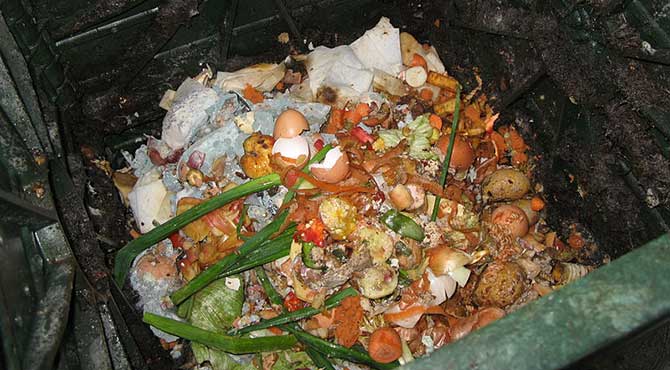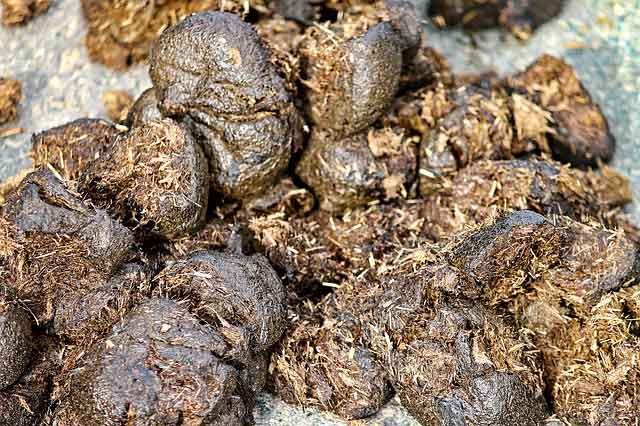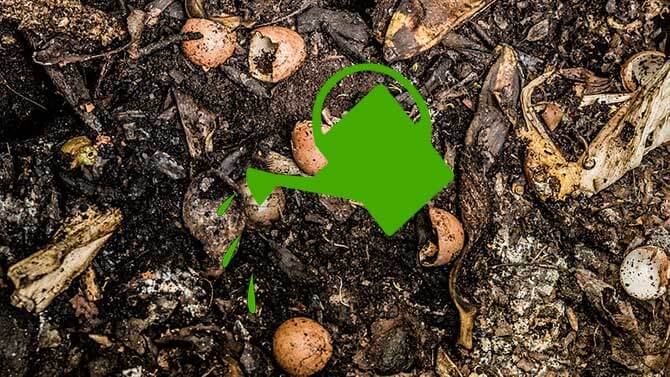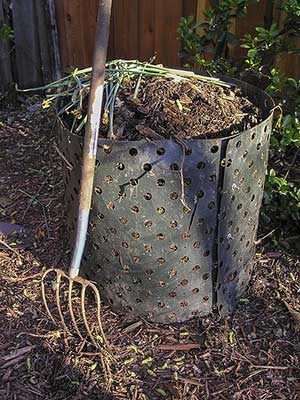Composting Guide: How To Make Compost at Home
Recently, I realized how many food scraps my family throws away. This simple fact aroused my interest in composting since we have a big garden with flowers, vegetables, trees and plants that could use all the benefits of compost.
Disclosure: This page contains affiliate links. This means that the owner of this website might be compensated for any qualifying purchases made via these links.
Contents
What is composting?
Composting is the nature’s way of decomposing organic matter into a material called “compost”, which is an exceptional organic soil reconditioner. This process is possible with the help of microorganisms, fungi, and insects that naturally break down the organic material.
Many gardeners use compost as a bio alternative to the synthetic fertilizers because the compost will provide the soil with a variety of nutrients that are very beneficial for the healthy growth of any plant.
Unlike the synthetic fertilizers where the nutrients are released quickly into the soil, compost is a slow-release fertilizer that delivers the nutrients gradually over a longer period of time.
You can make compost from many things. One of the most common ways of making compost at home is from food scraps.
Yes, those food scraps we throw away every day can be turned into an exceptional fertilizer for your garden or flowers.
Why to compost / Benefits of composting
As stated by thegoodhuman.com:
Each year, the typical American family throws out 2,460 pounds of paper, 540 pounds of metals, 480 pounds of glass and 480 pounds of food scraps.
That’s a lot of trash!
According to a 2010 study conducted by Boulder County, 46.6% of the trash produced by the inhabitants consisted of organic waste, where about 13-15% was just food waste.
Of course, this study is representative only for Boulder County and the numbers will vary from country to country and from an area to another. However, it’s enough to make a better idea of how many organic wastes that we could use we actually throw away.
Environmentally Friendly
With composting, you can turn a big part of that organic waste into natural fertilizer. Your plants will be happy and you’ll also protect the environment.
When the trash normally breaks down in the landfill, it releases methane, which is a heavy-duty greenhouse gas that is considered to massively contribute to climate change.
If the wastes decompose in the presence of oxygen (as it’s the case of composting), this process does not produce this harmful gas.
Improve soil water infiltration and retention
There are many types of soils that don’t retain water. You can efficiently solve this problem with compost.
A soil mixed with compost will help the water to reach the roots of your plants easier, your plants will receive more oxygen, and the humidity will be retained in the soil for a longer period of time.
Compost feeds the soil and your plants
Just as the human body needs minerals and vitamins, plants also need nutritive substances to grow healthy.
While we take the needed nutrients from food, plants take these substances from the soil.
If you continuously grow plants in the same soil, without utilizing any type of fertilizers, it will eventually become unfruitful due to the lack of nutrients.
If the soil lacks certain minerals, your plants won’t grow healthy and various plant diseases can occur.
The compost will help the soil recover its nutrients and your plants will grow happier and healthier.
Grow healthier vegetables without synthetic fertilizer
There are many types of synthetic fertilizers on the market and many of the vegetables we buy are fed with these chemicals.
While these force the plants to grow faster, these are very poisonous to the human body. Once we eat the fruits and vegetables grown with the help of these synthetic fertilizers, a part of these toxic substances enter our bodies and facilitate the occurrence of many diseases.
The homemade compost is 100% safe for you and your plants.
The plants will have a proper environment for natural growth, and your body won’t be intoxicated with dangerous chemicals.
Save money
If you have a garden or some flowers around your house, you have probably purchased fertilizer at least one time in your life.
By composting your food scraps, you will have a never-ending supply of fertilizer to feed your plants without the need of spending money on expensive fertilizers.
Composting types
There are two composting types depending on how you manage your compost.
1. Active Composting (also known as managed composting or HOT composting)
You need to actively watch, water and turn the pile occasionally.
Advantages:
- Your compost will be ready to use in a relatively short time (from several weeks to several months).
Disadvantages:
- Requires more attention and energy from your behalf.
2. Passive Composting (or COLD composting)
Passive composting is performed by adding all the materials in an ongoing pile and you let the mother nature to follow its course. There’s no need to pay too much care to your pile if you go this route.
Advantages:
- If you have enough space, you can do this on a large scale without minimal effort.
- You don’t need a composting tumbler or bin.
Disadvantages:
- It will take a long time for your compost to be ready (usually a year or more).
- You need a place where to leave your pile for a long time. Not recommended to do this in a small urban backyard.
Composting techniques
There are several ways of making compost. The most common are:
Compost made from food scraps

This compost type is made from household food scraps, plus organic components that contain a high level of Carbon such as dried leaves, hay, shredded newspaper, paper towels, etc.
The compost obtained from food scraps is very good for almost any sort of plants.
A big advantage of this compost type is that anyone has at his disposal the ingredients to produce it.
Manure compost

This type of compost is obtained from the wastes of herbivores like cows, horses, poultry, sheep, guinea pigs, rabbits, alpacas, llamas, goats, etc.
Manure is one of the best organic fertilizers and it’s used for this purpose since ancient times. However, it should never be used fresh as it contains a high amount of nitrogen which can burn your plants.
You can even mix manure with the composition for the compost made from food scraps.
When you use sheep manure, or other dry animal feces be careful because these may contain weed seeds that can rapidly spread into your garden.
Only use the wastes from herbivores and not from pets that consume meat, like cats and dogs. Due to the high amount of protein from their diet, the excrements of your pets are acidic and can contain many harmful bacterias.
Vermicompost (vermiculture, vermi-compost)

Vermicompost is the name of the process of decomposing organic matter into compost with the help of several species of earthworms (usually red wigglers or white worms).
The elements which follow to be decomposed by the worms are usually food wastes.
I will not get into too many details about vermicompost since this can be a very complex topic to talk about.
In this guide, I will only cover mainly how to make compost from food scraps.
How To Compost
The most two common ways of making your own compost at home are either making a compost pile (you can make it directly on the ground) or using a compost bin.
If you live in the countryside and you have a large space, you can just start a composting pile in a corner of your garden.

Make sure though that your compost pile it’s far enough from your neighbors and at a fair distance from any source of drinking water to avoid any contamination.
If you live in an urban area and you only have a small garden or backyard, then you will need a composting bin or a composting tumbler.

You can buy one from Amazon (this is the one I use), or you can make one yourself from wood pallets, old plastic trash bins, etc. There are many tutorials on YouTube on how to make your own compost bin.
The advantages of composting bins or tumblers over an open compost pile are that these recipients keep the insects away (spiders, bees, flies, bugs), protect your compost from rats, raccoons, and pets, and also maintain the moisture for a longer period of time.
Between the fixed bins and composting tumblers, I prefer the tumblers because are easier to use. It’s way more comfortable to rotate a composting tumbler than turning the mixture with a pitchfork (your back will thank you for that choice).
Before you become an expert, you first need to understand “what’s under the hood” and how the whole process works.
Composting it’s a process that involves a bit of chemistry. Hence, it’s not enough to just throw a bunch of food scraps into your composting bin and hope that they will transform into fertilizer.
Compost Requirements:
A compost mixture has four basic needs:
- Browns (Carbon)
- Greens (Nitrogen)
- Oxygen
- Water
The first two essential components that come into the mixture are “Browns” and “Greens“.
Browns can be dried leaves, hay, dried plants, cardboard or paper (since paper is made from wood), dried branches, etc.
Greens can be fruit and vegetable peels, lawn clippings, flowers, plants, etc.
Browns contain a high concentration of Carbon, while the greens contain a high level of Nitrogen.
Experts recommend that:
For the best compost, you should maintain a ratio of 30:1 Carbon-Nitrogen.
This ratio will offer the microorganisms the best environment for doing their job and convert the organic matter into fertilizer in the shortest time possible.
It’s almost impossible to determine the exact quantities of Carbon and Nitrogen you put into your compost pile without being a chemist. Therefore, do not stress too much about adding the perfect quantities.
If you don’t get it right from the first try, you can add more Greens or Brown along the way.
Besides these two elements, for the ingredients to decompose properly, your compost will also need to be well-ventilated and have the moisture of about 50%.
A compost mixture that’s too dry won’t heat up and won’t decompose correctly, while a compost that’s too moist, will rot and will get an ammonia smell.
It’s also very important to know what ingredients you can use for your compost.
What can I compost?
It’s strange how many things that people throw away can be composted. Did you know that hair, eggshells, fingernails, and even paper can be turned into fertilizer?
For a good compost, it’s essential to use the right ingredients.
If you don’t use the right elements, your compost might get a bad odor, will attract pests, insects, and so on.
GREENS
- Any fruits and vegetables (including peels)
- Flowers
- Garden plant stalks
- Seedless weeds
- Grass clippings
- Hair
BROWNS
- Dried leaves
- Sawdust
- Wood chips
- Coffee grounds, coffee beans, coffee filters, and tea bags
- Cardboard / Paper that was not treated with chemical substances
- Dried tree branches
- Hay & straw
- Nutshells
- Corn Cobs
NEUTRALS
- Eggshells
- Wood ash
What NOT to compost
- Meat
- Cheese
- Bones
- Weeds with seeds
- Cardboard / Paper that has been treated with chemical substances
- Generally, any cooked food or leftovers that would attract pests or catch a bad smell
- Diseased plants
- Charcoal ashes
- Synthetic fibers
- Sticky labels on fruits and vegetables
- Large Branches
- Dog/Cat feces
There are many other items that can be added to your pile.
Even some of the items from my “what NOT to compost” list can be used, but I would say that these require additional care because these can attract unwanted pests, insects, and pets.
Composting Steps
After you have all your Greens and Browns, it’s time to mix all the ingredients together.
If you start a composting pile or you make your compost in a static bin, you should arrange the Greens and Browns in layers.
Start with a layer of dried leaves, sawdust, dry tree branches, or any Carbon-reach items that will permit a bit of oxygen flow under your pile.
Continue by adding a layer of food scraps and then add another layer of dried ingredients until you utilize all the materials.
When you use a compost tumbler, you can just throw all the materials inside. Rotate the container several times after to obtain a homogeneous mixture.
Compost care and maintenance
It’s not enough to throw everything together and just wait for the materials to turn into fertilizer. You need to watch and take care of your compost mixture periodically.
How wet or dry should my compost be?

First, you have to make sure that the composition has enough moisture. Otherwise, it will take very long for the ingredients to decompose.
When compost has enough humidity, the mixture should warm up (that’s when you know that the bacterias and the microorganisms do their job).
At the touch, the mixture should have the feel of a wrung-out wet sponge (not very dry, but also there should be no water dripping from it).
During the summer, you might have to water the compost from time to time in order to maintain the proper humidity level (if you’re working with a pile, you can also cover it with a tarp).
A compost that’s too dry might also be a sign that you’ve added too many Browns and too little Greens. Therefore, adding more green stuff might help.
How often should I turn compost?

Besides water, your compost mixture also needs oxygen for the elements to decompose.
If you want to speed up the composting process, you should turn and mix your compost regularly (more often when you start the compost and less frequently when the content gets older).
There’s no written rule about how often you should mix your compost. Some people turn a pile once every few days, while other people just mix it once every few weeks or once a month.
I’d say that turning a pile once every two weeks it’s just enough. If you want to speed up the process though, you can probably do that more often.
If you use a compost tumbler instead of a pile, you can just turn it once every 3-5 days. Just spin the tumbler a few times and the mixture should receive enough oxygen for the bacterias to do their job.
When is the compost ready to use?

The time it takes for your compost to be ready depends on many factors such as the work you put in managing your compost pile, how large your pile is, the time of year when you started composting (it usually takes more time for your compost to mature in the winter and less during the summer), what ingredients you’ve added to the mixture, and so on.
Usually, when the composition doesn’t look like the stuff you put in (you can’t notice food scraps, grass, sticks, etc.) and looks like a homogeneous dark black earthy material, then you have mature compost that’s ready to use in your garden.
The final compost should also have a pleasant earthy smell and not a stinking odor that resembles ammonia.
How to speed up composting?

First of all, you need to keep in mind that the more you manage your compost, the quicker the compost will be ready to use.
Besides that, there are a few additional things you can do if you want to make compost faster:
- Turn your compost more often (using a compost tumbler will help).
- Chop the ingredients before adding them to the mix.
- Avoid adding components that decompose slowly.
- Add a compost accelerator to the mix
- Avoid making your compost pile too big.
Conclusion
Making compost might sound complicated, but it really isn’t.
Annually, a family throws away massive amounts of organic waste that ends up getting into the landfill.
Composting is an environmentally-friendly way to get rid of a part of the homestead produced garbage and turning this waste into natural fertilizer for your garden and plants.
I hope you got some valuable tips from this guide.
Let me know in the comments how you make compost.

